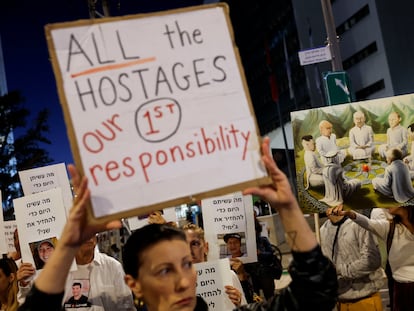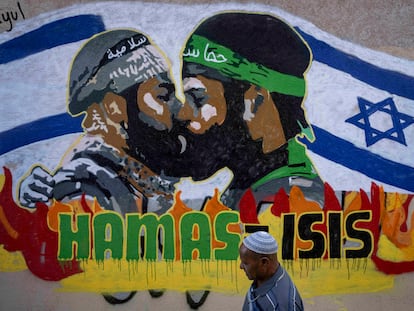Israel says beginning of truce and prisoner-for-hostage swap delayed to Friday
The agreement, which also involves the entry of humanitarian aid into the Strip, was to begin to be implemented Thursday morning. Shortly before its entry into force, the Israeli national security advisor clarified that it would not take place before Friday due to last minute differences
The fragility of the agreement between Israel and Hamas was exposed in the early hours of Thursday. As the two sides neared the start of a four-day truce, Israeli national security advisor Tsaji Hanegbi announced that the ceasefire - accompanied by an exchange of hostages for Palestinian prisoners and the entry into Gaza of hundreds of trucks of humanitarian aid - would not begin until at least Friday. Shortly afterwards, an Israeli government source accused Hamas of not having handed over the list of hostages to be released and not having signed the agreement with the Qatari mediators. The last-minute discrepancies show why Israelis and Palestinians held their breath as the final details of a deal that has raised the hopes of many families on both sides were negotiated in Qatar. Now, barring a last-minute change, the shelling and clashes will continue this Thursday in Gaza for the 48th consecutive day. On Wednesday, when the implementation of the pact was still seen as imminent, Israeli Prime Minister Benjamin Netanyahu reaffirmed that the agreement with Hamas, the greatest diplomatic milestone of the conflict, will in no way be the prelude to the definitive cessation of attacks. “We are at war, and we will continue the war,” he said. “We will continue until we achieve all our goals.”
On Wednesday, Hamas announced that the deal would begin to be implemented at 10 a.m. the following day. Israeli public television even placed the exchange between 10:00 and 16:00. The stumbling block, according to the Israeli version, is the signing of the pact and the list of names of the hostages that Hamas had planned to hand over in Qatar, where the head of the Mossad, the secret services abroad, David Barnea, is currently stationed. An Israeli government source suggests that the differences can be resolved within 24 hours.
Hours earlier, Gershon Baskin, a peace activist who negotiated with Hamas the swap of a thousand Palestinian prisoners for the surrender of the soldier Guilad Shalit in 2011, warned of the “difficulty” of the truce lasting four days, given the “lack of trust” between the parties and of direct contacts, which are made through the mediators: Qatar, Egypt and the United States. “There is a lot of emotion, a lot of anger, a lot of hatred and a lot of chances for people to shoot each other,” he pointed out to this newspaper in a voice message.
Legally, the agreement could be applied from early Thursday morning, 24 hours after the Israeli Justice Ministry published the list of 300 potential prisoners to be released, mostly men with minor offenses, plus 30 women. None are charged with murder, although some are charged with attempted murder. Nor have they been arrested in the wave of arrests after October 7, but before that date. Since then, the number of Palestinian prisoners has risen from about 5,300 to 8,000.
More than half of those on the list have not yet been tried. Some of the offenses attributed to them have long been denounced by human rights NGOs for their vagueness, such as “harming the security of the area”; their disproportionate punishment (for throwing stones); or for violating the right of assembly, such as attending a demonstration. In the occupied West Bank, Palestinians are subject to military jurisdiction and Israeli settlers to civilian jurisdiction.
Why, if only 150 prisoners will be released during the four-day truce, does the list contain 300 names? The difference is due to the fact that the pact includes the possibility of a four-day extension. It would be with the same ratio: one hostage for every three Palestinian prisoners. If completed, it would mean the delivery of some 98 hostages and the release of all the prisoners on the list.
The families of the hostages will only know if their family members are released when they are already in Israeli territory. There they will be transferred to special areas in hospitals, with psychological support and away from the rest of the patients and the media. The motive, in a situation as fluid as that reflected in the last-minute postponement, is not to give hope to the families until it is certain that the same person whose name appears on the list has been handed over.
At a press conference late in the day, Netanyahu attributed the agreement with Hamas to a mix of massive military pressure in Gaza and great diplomatic pressure. Also, to the help of U.S. President Joe Biden, who lobbied and succeeded in “improving conditions” to Israel’s benefit. The Prime Minister insisted that it is time to “wait” to recover the rest of the hostages. “A military operation is not always possible” to rescue them, he said. For his part, Defense Minister Yoav Gallant said that any advance by Israeli troops “increases the chances” of further hostage releases. “Hamas only understands force,” he added, calling the terror group “barbarians.”
Drone attack
Meanwhile, clashes in Gaza continued throughout the day: a bombing killed 52 members of the same family in the Jabaliya refugee camp. Moreover, in the West Bank, where violence has been escalating since October 7, six people were killed by drone fire during an Israeli raid on the town of Tulkarem. It is a means increasingly employed by the Israeli Armed Forces after two decades with little recourse to air strikes in that territory.
The bombing was part of the assault by the occupation troops on Tabet hospital, to which several vehicles and about fifteen uniformed men moved at around 4:00 a.m., threatening part of the medical team at gunpoint, according to local journalist Sami Saai. They took away at least one of the wounded from the drone attack who had been taken by ambulance to the center, as Saai shows in a video of the scene, in which he describes how the soldiers also prevented the free movement of ambulances.
Other health infrastructures were also destroyed, such as one of the first aid centers in the refugee camp, which was equipped with material from Médecins Sans Frontières (MSF), according to the coordinator of this NGO in the area, Luz Saavedra. The facilities were hit by numerous bullets and were stormed by several members of the military. Six of the paramedics working in the camp were detained by the troops and taken away with their hands tied and at gunpoint in a group of about twenty of those arrested, as can be seen in a video recorded in the streets. MSF had to make arrangements for their subsequent release.
The army bulldozers also remained for several hours in Tulkarem camp causing damage to houses, water infrastructure and asphalted streets, as they had already done on two other occasions since the war began on October 7. Before leaving, they left large earthen barricades cutting off several accesses. Wednesday’s was the third military incursion by the Israeli army into the camp.
Saavedra considers that these military attacks and the blockade of health facilities are a “worrying trend”, as well as going against international humanitarian law, since from the moment a person is wounded he ceases to be a combatant, as long as he renounces to carry out hostile acts. The outbreak of war, he says, has caused the situation of siege and harassment of health facilities to “deteriorate further”.
Mass grave
Meanwhile, in Gaza, the outskirts of the southern town of Khan Yunis have been the scene of the burial in a mass grave of more than 111 bodies of victims of Israeli attacks transferred from the north of the Strip, where they have not been able to receive burial. Some came from the Al Shifa hospital, the largest in the Palestinian enclave, where troops have been stationed for more than a week. Gaza City, the main stronghold of Hamas, is located in the north of the Strip.
Some UN agencies, such as Unicef or the World Health Organization, consider that the greater flow of aid that will arrive in Gaza these days thanks to the truce will not be enough to face the serious crisis faced by a population of 2.3 million people, 75% of whom have become internally displaced.
Sign up for our weekly newsletter to get more English-language news coverage from EL PAÍS USA Edition
Tu suscripción se está usando en otro dispositivo
¿Quieres añadir otro usuario a tu suscripción?
Si continúas leyendo en este dispositivo, no se podrá leer en el otro.
FlechaTu suscripción se está usando en otro dispositivo y solo puedes acceder a EL PAÍS desde un dispositivo a la vez.
Si quieres compartir tu cuenta, cambia tu suscripción a la modalidad Premium, así podrás añadir otro usuario. Cada uno accederá con su propia cuenta de email, lo que os permitirá personalizar vuestra experiencia en EL PAÍS.
¿Tienes una suscripción de empresa? Accede aquí para contratar más cuentas.
En el caso de no saber quién está usando tu cuenta, te recomendamos cambiar tu contraseña aquí.
Si decides continuar compartiendo tu cuenta, este mensaje se mostrará en tu dispositivo y en el de la otra persona que está usando tu cuenta de forma indefinida, afectando a tu experiencia de lectura. Puedes consultar aquí los términos y condiciones de la suscripción digital.
More information
Archived In
Últimas noticias
Trump claims peace in Ukraine is near, but Moscow suggests otherwise
A survivor’s account of the Interoceanic Train accident: ‘We were scared because of the speed on the curve’
The Interoceanic Train, the Mexican alternative to the Panama Canal
What is known about the Interoceanic Train derailment in Oaxaca
Most viewed
- Oona Chaplin: ‘I told James Cameron that I was living in a treehouse and starting a permaculture project with a friend’
- Reinhard Genzel, Nobel laureate in physics: ‘One-minute videos will never give you the truth’
- Why the price of coffee has skyrocketed: from Brazilian plantations to specialty coffee houses
- Pablo Escobar’s hippos: A serious environmental problem, 40 years on
- Chevy Chase, the beloved comedian who was a monster off camera: ‘Not everyone hated him, just the people who’ve worked with him’










































